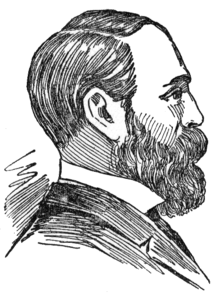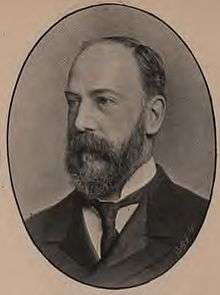Sir Charles Dilke, 2nd Baronet
| Sir Charles Dilke, Bt | |
|---|---|
|
Image from an Ogden's Cigarette Card | |
| Born | 4 September 1843 |
| Died | 26 January 1911 (aged 67) |
| Nationality | British |
| Education | Trinity Hall, Cambridge |
| Known for |
Liberal Party MP President of the Local Government Board, 1882–1885 |
| Spouse(s) | Emilia Strong (1840–1904) |
Sir Charles Wentworth Dilke, 2nd Baronet PC (4 September 1843 – 26 January 1911) was an English Liberal and Radical politician. A republican in the early 1870s, he later became a leader in the radical challenge to Whig control of the Liberal Party, making a number of important contributions, including the legislation increasing democracy in 1883-85, his support of the growing labour and feminist movements, and his prolific writings on international affairs. Touted as a future prime minister, his aspirations to higher political office were effectively terminated in 1885, after a notorious and well-publicised divorce case. His disgrace, and the alignment of Joseph Chamberlain with the Conservatives, greatly weakened the radical cause.[1]
Background and education
Dilke was the son of Sir Charles Dilke, 1st Baronet. He was educated at Trinity Hall, Cambridge, where he was President of the Cambridge Union Society.[2] His second wife was the author, art historian, feminist and trade unionist Emily Francis Pattison née Strong (widow of the Revd Mark Pattison), subsequently known as Lady Dilke.[3]
Despite being a radical, Dilke was also an imperialist, arguing for British imperial domination in his best-selling 1868 book Greater Britain.[4]
Political career, 1868–1886

Dilke became Liberal Member of Parliament for Chelsea in 1868, a seat he held until 1886.
In 1871, Dilke caused controversy when he criticised the British Monarchy and argued that the United Kingdom should adopt a republican form of government; public criticism made Dilke recant this position.[4]
He was Under-Secretary of State for Foreign Affairs from 1880 to 1882, during Gladstone's second government, and was admitted to the Privy Council in 1882. In December 1882 he entered the cabinet as President of the Local Government Board, serving until 1885. A leading and determined radical within the Liberal party, he negotiated the passage of the Third Reform Act, which the Conservatives allowed through the House of Lords in return for a redistribution calculated to be marginally favourable to themselves (the granting of the vote to agricultural labourers threatened Conservative dominance of rural seats, but in return many double-member seats were abolished and seats redistributed to suburbia, where Conservative support was growing). He also supported laws giving the municipal franchise to women, legalising labour unions, improving working conditions and limiting working hours, as well as being one of the earliest campaigners for universal schooling.
The Crawford scandal

Dilke's younger brother, Ashton Wentworth Dilke, married May Eustace Smith, the eldest daughter of Liberal politician and shipowner Thomas Eustace Smith and his wife Ellen, in 1876. Sir Charles Dilke became Ellen's lover, a relationship which continued after his marriage in 1884. In July 1885, however, he was accused of seducing the Eustace Smiths' daughter Virginia in the first year of her marriage to Donald Crawford, MP. This was supposed to have occurred in 1882, when Virginia was 19, and she claimed that the affair had continued on an irregular basis for the next two and a half years.
Crawford sued for divorce, and the case was heard on 12 February 1886 before The Hon. Mr Justice Butt in the Probate, Divorce and Admiralty Division. Virginia Crawford was not in court and the sole evidence was her husband's account of Virginia's confession. There were also some accounts by servants, which were both circumstantial and insubstantial. Dilke, aware of his vulnerability over the affair with Virginia's mother, refused to give evidence, largely on the advice of his confidant Joseph Chamberlain. Butt found – paradoxically – that Virginia had been guilty of adultery with Dilke, but that there was no admissible evidence to show that Dilke had been guilty of adultery with Virginia. He concluded, "I cannot see any case whatsoever against Sir Charles Dilke," dismissed Dilke from the suit with costs, and pronounced a decree nisi dissolving the Crawfords' marriage.[5]
The paradoxical finding left doubts hanging over Dilke's respectability, and investigative journalist William Thomas Stead launched a public campaign against him. Two months later, in April, Dilke sought to re-open the case and clear his name by making the Queen's Proctor a party to the case and opposing the decree absolute.[6] Unfortunately, Dilke and his legal team had badly miscalculated (his legal advice has been described as "perhaps the worst professional advice ever given"). Though they had planned to subject Virginia to a searching cross-examination, Dilke, having been dismissed from the case, had no locus standi. As a consequence it was Dilke who was subjected to severe scrutiny in the witness box by Henry Matthews. Matthews' attack was devastating and Dilke proved an unconvincing witness. His habit of physically cutting pieces out of his diary with scissors was held up to particular ridicule, as it created the impression that he had cut out evidence of potentially embarrassing appointments. The jury found that Virginia had presented the true version of the facts, and that the decree absolute should be granted.
Dilke was ruined. Other women claimed he had approached them for a liaison. Various lurid rumours circulated about his love-life, including that he had invited a maidservant to join himself and his lover in bed, and that he had introduced one or more of these to "every kind of French vice", and he became a figure of fun in bawdy music-hall songs.[7] For a time it seemed that he would be tried for perjury, although this did not eventuate.[5] The accusations had a devastating effect on his political career, leading eventually to the loss of his parliamentary seat (Chelsea) in the 1886 UK general election.[5] Matthews, on the other hand, gained public acclaim, winning the seat of Birmingham East as a Conservative at the same election. Queen Victoria, who approved of his performance in the trial, demanded that he be included in Lord Salisbury's cabinet, and he was made Home Secretary. The Queen had asked in vain for Dilke to be stripped of his membership of the Privy Council.[7]
Dilke spent much of the remainder of his life and much of his fortune trying to exonerate himself, and this adds weight to the view that Virginia lied about the identity of her lover. Over the years it has been suggested that political colleagues of Dilke's, including Archibald Primrose, 5th Earl of Rosebery, and Chamberlain himself,[5] may have inspired Mrs Crawford to accuse him, seeing him as an obstacle to their own ambitions. Dilke was largely exonerated by an inquiry in the early 1890s, which cast doubt on the truthfulness of Virginia's evidence - her description of their alleged love-nest in Warren Street was full of inaccuracies. It appears that she may well have been attempting to distract attention from an earlier affair with one Captain Forster.[7]
Political career after 1886

Dilke lost his Chelsea parliamentary seat at the 1886 general election.[8] In 1889 he was approached by the Forest of Dean Liberal Association to stand as their parliamentary candidate since his radical credentials suited the mining constituency seeking employment law reform.[9] Hoping that he could be rehabilitated as a front-line politician, Dilke consulted Liberal leader William Gladstone, who discouraged him, and so Dilke did not pursue the offer.[10] Three years later, however, Dilke accepted the invitation – against Gladstone’s wishes - and at the 1892 general election was duly elected as the MP for the Forest of Dean, a position he held for the remainder of his life.[11]
He had hoped to be appointed Secretary of State for War in the Liberal Government formed in 1905, but this was not to be. Dilke attributed this to the incoming Prime Minister Henry Campbell-Bannerman's lingering resentment towards Dilke for his role in the 1895 "cordite vote" which had brought about the end of Lord Rosebery's administration in 1895.[12]
In popular culture
Following his death, fund raising commenced to establish a local community hospital in his Forest of Dean constituency. The Dilke Memorial Hospital, Cinderford, opened its doors for the first time in 1923 and still exists as a permanent memorial to the popular M.P.
In the 1994 film Sirens, detailing sexual licence in Australia in the 1930s, the local pub is called the "Sir Charles Dilke".
Notes
- ↑ David Nicholls, The Lost Prime Minister (1995)
- ↑ "Dilke, Charles (DLK862CW)". A Cambridge Alumni Database. University of Cambridge.
- ↑ Dictionary of Art historians: "Emilia, Lady Dilke"
- 1 2 Thomas M. Costa, "Dilke, Charles Wentworth" in Historical Dictionary of the British Empire edited by James S. Olson and Robert Shadle. Greenwood Press, 1996 ISBN 0-313-27917-9
- 1 2 3 4 Jenkins (2004)
- ↑ Crawford v. Crawford and Dilke (The Queen's Proctor intervening) (1886) 11 PD 150
- 1 2 3 Nicholls 1995, p188, 191-2
- ↑ Jenkins p259
- ↑ Jenkins p376
- ↑ Jenkins pp377-9
- ↑ Jenkins pp382-7
- ↑ Jenkins pp410-1
Bibliography
- Chamberlain, M. E. "Sir Charles Dilke and the British Intervention In Egypt, 1882: decision making In a nineteenth-century cabinet." British Journal of International Studies 2#3 (1976): 231-245.
- Gwynn, S.; Tuckwell, G. (1917). The life of the Rt. Hon. Sir Charles W. Dilke. London: John Murray.; A denial of the scandal prepared by his niece
- Jenkins, R (1996). Dilke: A Victorian tragedy. London: Papermac. ISBN 0-333-62020-8.; Emphasis on the scandal
- Nicholls, David (1995). The Lost Prime Minister: Life of Sir Charles Dilke. London: Hambledon Continuum. ISBN 1-852-85125-2.
- — "Dilke, Sir Charles Wentworth, second baronet (1843–1911)". Oxford Dictionary of National Biography (online ed.). Oxford University Press. 2004. doi:10.1093/ref:odnb/32824. (Subscription or UK public library membership required.)
- "Dilke, Charles Wentworth (DLK862CW)". A Cambridge Alumni Database. University of Cambridge.
Primary sources
- Dilke, Charles Wentworth. (1868). Greater Britain. Macmillan (reissued by Cambridge University Press, 2009; ISBN 978-1-108-00301-8)
External links
| Wikimedia Commons has media related to Sir Charles Dilke. |
- Works by Charles Wentworth Dilke at Project Gutenberg
- Works by or about Sir Charles Dilke, 2nd Baronet at Internet Archive
- Hansard 1803–2005: contributions in Parliament by Sir Charles Dilke
 The Rowers of Vanity Fair – Dilke, Charles Wentworth – “A Far Advanced Radical” at Wikibooks
The Rowers of Vanity Fair – Dilke, Charles Wentworth – “A Far Advanced Radical” at Wikibooks Works written by Sir Charles Wentworth Dilke, 2nd baronet.
Works written by Sir Charles Wentworth Dilke, 2nd baronet.- "Archival material relating to Sir Charles Dilke, 2nd Baronet". UK National Archives.
- Portraits of Sir Charles Wentworth Dilke, 2nd Bt at the National Portrait Gallery, London

- Blue Plaque at 76 Sloane Street, Brompton, London
| Parliament of the United Kingdom | ||
|---|---|---|
| New constituency | Member of Parliament for Chelsea 1868–1886 With: Sir Henry Hoare, Bt 1868–1874 William Gordon 1874–1880 Joseph Firth Bottomley Firth 1880–1885 |
Succeeded by Charles Algernon Whitmore |
| Preceded by Godfrey Blundell Samuelson |
Member of Parliament for Forest of Dean 1892–1911 |
Succeeded by Henry Webb |
| Political offices | ||
| Preceded by Hon. Robert Bourke |
Under-Secretary of State for Foreign Affairs 1880–1882 |
Succeeded by Lord Edmond FitzMaurice |
| Preceded by John George Dodson |
President of the Local Government Board 1882–1885 |
Succeeded by Arthur Balfour |
| Baronetage of the United Kingdom | ||
| Preceded by Charles Wentworth Dilke |
Baronet (of Sloane Street) 1869–1911 |
Succeeded by Charles Wentworth Dilke |